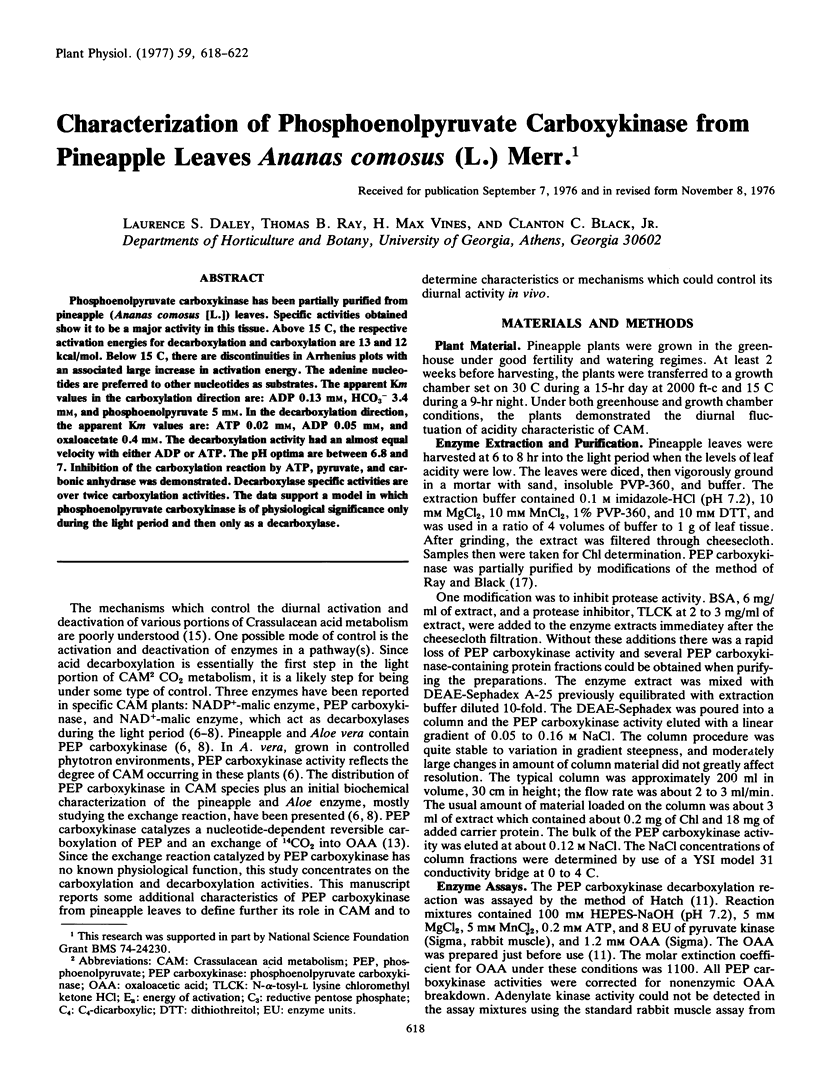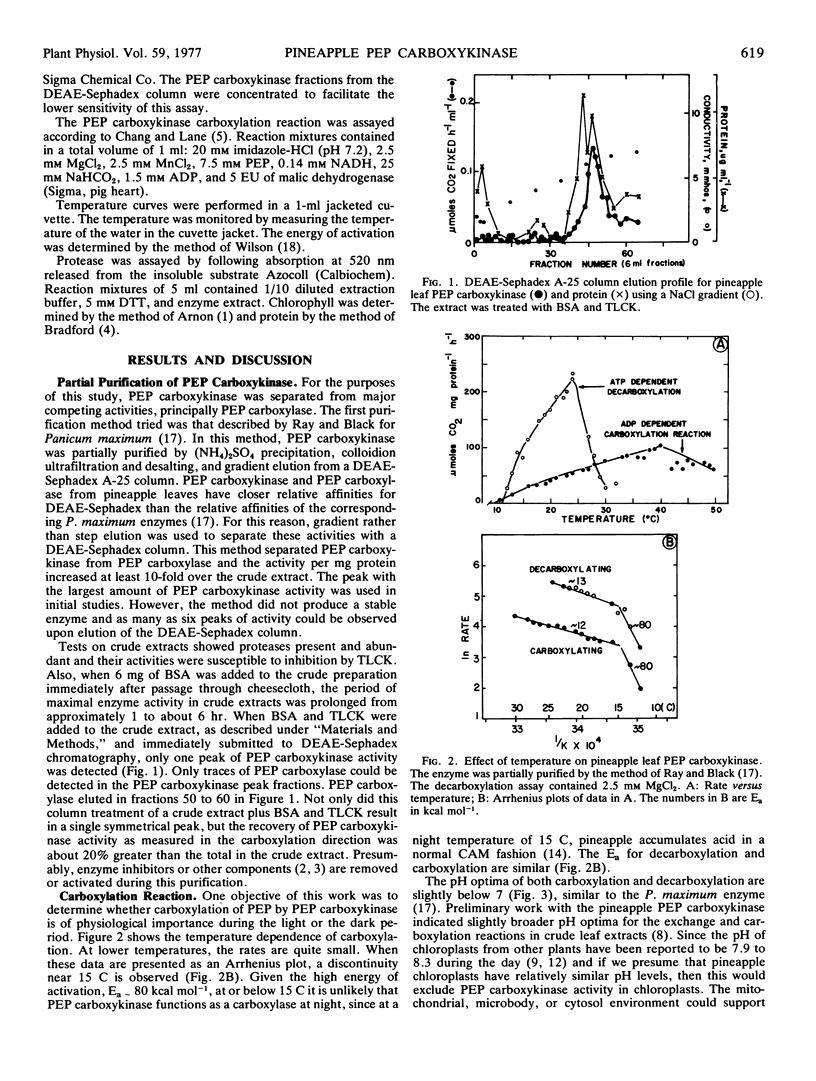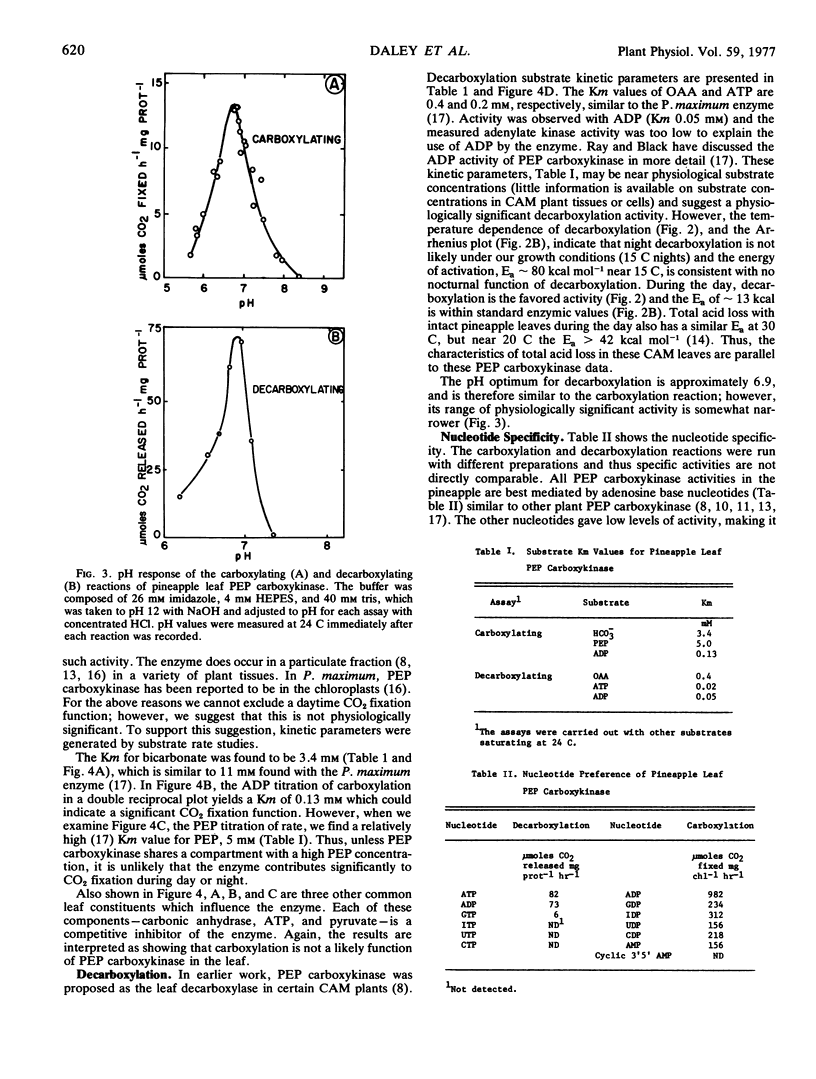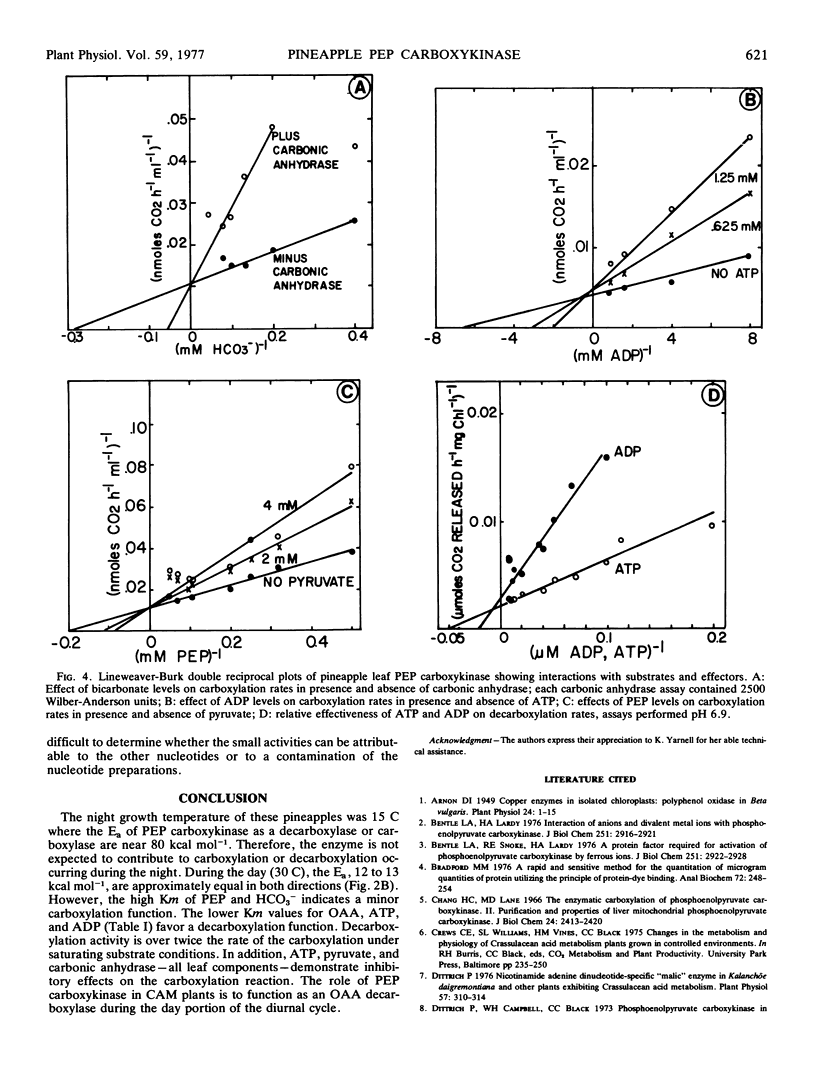Abstract
Phosphoenolpyruvate carboxykinase has been partially purified from pineapple (Ananas comosus [L.]) leaves. Specific activities obtained show it to be a major activity in this tissue. Above 15 C, the respective activation energies for decarboxylation and carboxylation are 13 and 12 kcal/mol. Below 15 C, there are discontinuities in Arrhenius plots with an associated large increase in activation energy. The adenine nucleotides are preferred to other nucleotides as substrates. The apparent Km values in the carboxylation direction are: ADP 0.13 mm, HCO3- 3.4 mm, and phosphoenolpyruvate 5 mm. In the decarboxylation direction, the apparent Km values are: ATP 0.02 mm, ADP 0.05 mm, and oxaloacetate 0.4 mm. The decarboxylation activity had an almost equal velocity with either ADP or ATP. The pH optima are between 6.8 and 7. Inhibition of the carboxylation reaction by ATP, pyruvate, and carbonic anhydrase was demonstrated. Decarboxylase specific activities are over twice carboxylation activities. The data support a model in which phosphoenolpyruvate carboxykinase is of physiological significance only during the light period and then only as a decarboxylase.
Full text
PDF




Selected References
These references are in PubMed. This may not be the complete list of references from this article.
- Arnon D. I. COPPER ENZYMES IN ISOLATED CHLOROPLASTS. POLYPHENOLOXIDASE IN BETA VULGARIS. Plant Physiol. 1949 Jan;24(1):1–15. doi: 10.1104/pp.24.1.1. [DOI] [PMC free article] [PubMed] [Google Scholar]
- Bentle L. A., Lardy H. A. Interaction of anions and divalent metal ions with phosphoenolpyruvate carboxykinase. J Biol Chem. 1976 May 25;251(10):2916–2921. [PubMed] [Google Scholar]
- Bentle L. A., Snoke R. E., Lardy H. A. A protein factor required for activation of phosphoenolpyruvate carboxykinase by ferrous ions. J Biol Chem. 1976 May 25;251(10):2922–2928. [PubMed] [Google Scholar]
- Bradford M. M. A rapid and sensitive method for the quantitation of microgram quantities of protein utilizing the principle of protein-dye binding. Anal Biochem. 1976 May 7;72:248–254. doi: 10.1006/abio.1976.9999. [DOI] [PubMed] [Google Scholar]
- Chang H. C., Lane M. D. The enzymatic carboxylation of phosphoenolpyruvate. II. Purification and properties of liver mitochondrial phosphoenolpyruvate carboxykinase. J Biol Chem. 1966 May 25;241(10):2413–2420. [PubMed] [Google Scholar]
- Dodd W. A., Bidwell R. G. The Effect of pH on the Products of Photosynthesis in CO(2) by Chloroplast Preparations from Acetabularia mediterranea. Plant Physiol. 1971 Jun;47(6):779–783. doi: 10.1104/pp.47.6.779. [DOI] [PMC free article] [PubMed] [Google Scholar]
- Edwards G. E., Kanai R., Black C. C. Phosphoenolpyruvate carboxykinase in leaves of certain plants whick fix CO 2 by the C 4 -dicarboxylic acid cycle of photosynthesis. Biochem Biophys Res Commun. 1971 Oct 15;45(2):278–285. doi: 10.1016/0006-291x(71)90814-x. [DOI] [PubMed] [Google Scholar]
- Hatch M. D. An assat for PEP carboxykinase in crude tissue extracts. Anal Biochem. 1973 Mar;52(1):280–285. doi: 10.1016/0003-2697(73)90350-3. [DOI] [PubMed] [Google Scholar]
- Heldt W. H., Werdan K., Milovancev M., Geller G. Alkalization of the chloroplast stroma caused by light-dependent proton flux into the thylakoid space. Biochim Biophys Acta. 1973 Aug 31;314(2):224–241. doi: 10.1016/0005-2728(73)90137-0. [DOI] [PubMed] [Google Scholar]
- Mazelis M., Vennesland B. Carbon Dioxide Fixation into Oxalacetate in Higher Plants. Plant Physiol. 1957 Nov;32(6):591–600. doi: 10.1104/pp.32.6.591. [DOI] [PMC free article] [PubMed] [Google Scholar]
- Rathnam C. K., Edwards G. E. Intracellular localization of certain photosynthetic enzymes in bundle sheath cells of plants possessing the C4 pathway of photosynthesis. Arch Biochem Biophys. 1975 Nov;171(1):214–225. doi: 10.1016/0003-9861(75)90026-0. [DOI] [PubMed] [Google Scholar]
- Ray T. B., Black C. C. Characterization of Phosphoenolpyruvate Carboxykinase from Panicum maximum. Plant Physiol. 1976 Nov;58(5):603–607. doi: 10.1104/pp.58.5.603. [DOI] [PMC free article] [PubMed] [Google Scholar]
- Wilson J. E. An expeditious method for determining the activation energies of enzymatic reactions. Arch Biochem Biophys. 1971 Dec;147(2):471–474. doi: 10.1016/0003-9861(71)90403-6. [DOI] [PubMed] [Google Scholar]


